Brother PT-580C User Manual
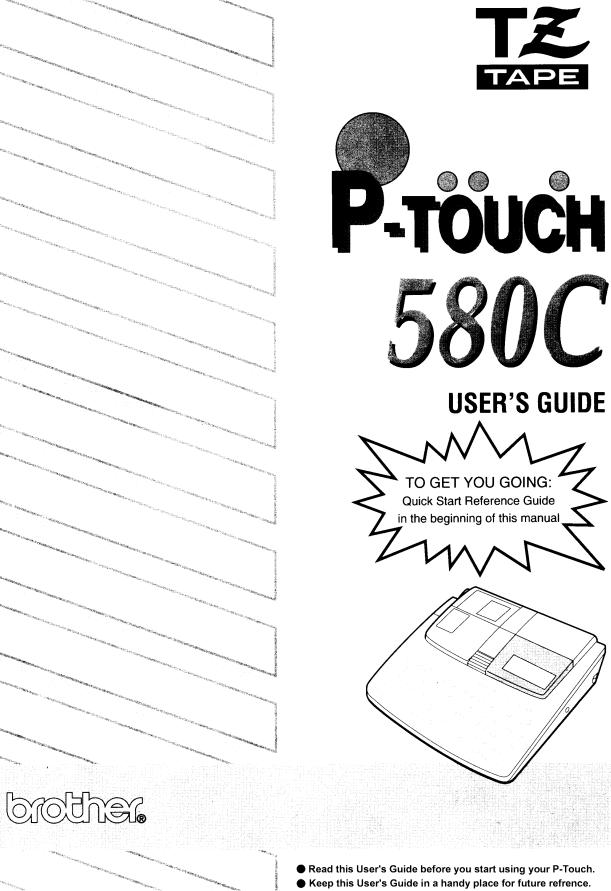
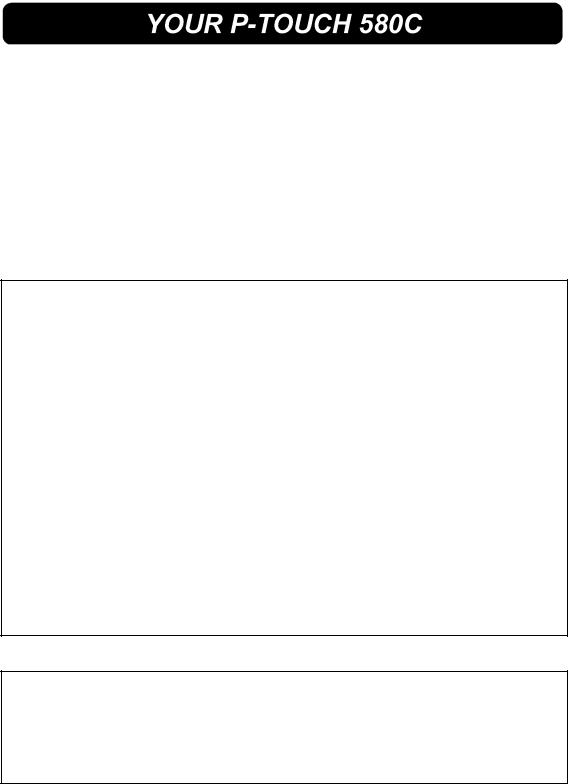
Thank you for purchasing the P-touch 580C!
Your new P-touch will allow you to design and print labels and stamps for any use. Your labels and stamps can contain characters of many sizes and styles as well as bar codes and graphics imported from other Windows applications. In addition, by using the variety of tape and ink cartridges available, you can print labels with different widths and exciting colors.
You no longer have to worry about urgent tasks that require professional printing. In the office, the factory, the lab and the home, the quality and performance of the P-Touch 580C makes it a very versatile machine.
Finally, as you may want to refer to this manual occasionally, we suggest that you keep it in a handy place.
FCC NOTICE
This equipment has been tested and found to comply with the limits for Class B digital device, pursuant to Part 15 of the FCC Rules. These limits are designed to provide reasonable protection against harmful interference in a residential installation. This equipment generates, uses, and can radiate radio frequency energy and, if
not installed and used in accordance with the instructions, may cause harmful interference to radio communications. However, there is no guarantee that interference will not
occur in a particular installation. If this equipment does cause harmful interference to radio or television reception, which can be determined by turning the equipment off and on, the user is encouraged to try to correct the interference by one of more of the following measures:
Reorient or relocate the receiving antenna.
Increase the separation between the equipment and receiver.
Connect the equipment into an outlet on a circuit different from that to which the receiver is connected.
Consult the dealer or an experienced radio/TV technician for help.
The enclosed interface cable should be used in order to ensure compliance with the limits for a Class B digital device.
Changes or modifications not expressly approved by Brother Industries, Ltd. could void the user’s authority to operate the equipment.
This product is covered by one or more of the following patents.
USP4839742 |
USP4983058 |
EP315369 |
GB2223740 |
USP4922063 |
USP5009530 |
EP322918 |
|
USP4927278 |
USP5069557 |
EP322919 |
|
USP4966476 |
USP5120147 |
|
|
USP4976558 |
|
|
|
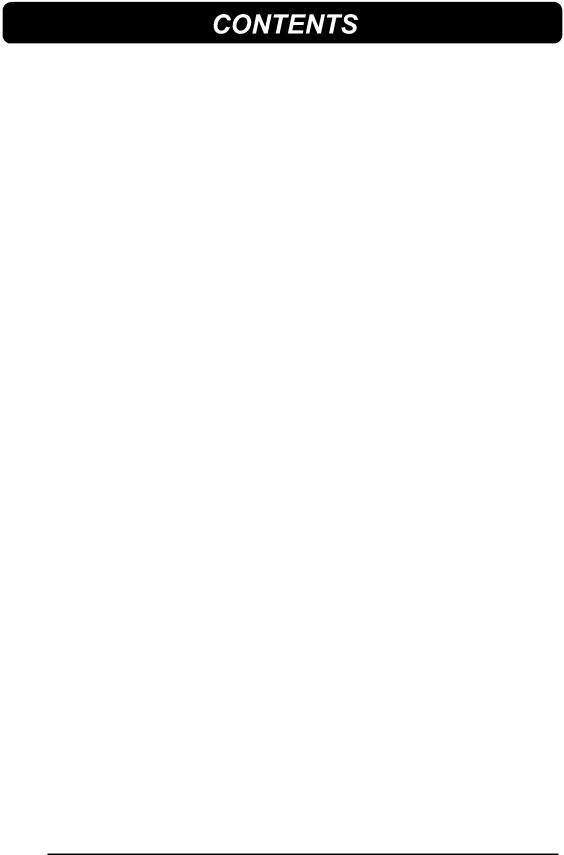
ABOUT THIS MANUAL................................................................................................................. |
1 |
QUICK REFERENCE GUIDE |
|
BEFORE YOU START |
|
MACHINE DIAGRAM...................................................................................................... |
6 |
GENERAL PRECAUTIONS ............................................................................................ |
8 |
POWER SUPPLY ........................................................................................................... |
9 |
OPTIONAL AC ADAPTOR............................................................................................ |
10 |
COMPUTER CONNECTION ........................................................................................ |
11 |
TAPE CASSETTES ...................................................................................................... |
12 |
REMOVING THE LABEL BACKING ............................................................................. |
15 |
CLEANING THE PRINT HEAD AND ROLLERS .......................................................... |
16 |
LEARNING THE ROPES |
|
INTRODUCTION........................................................................................................... |
18 |
DOOR SIGN EXAMPLE................................................................................................ |
19 |
EQUIPMENT LABEL EXAMPLE................................................................................... |
24 |
ADDRESS LABEL EXAMPLE....................................................................................... |
34 |
STOREGE SHELF LABEL EXAMPLE.......................................................................... |
38 |
FOR YOUR INFORMATION |
|
INTRODUCTION........................................................................................................... |
46 |
FINDING YOUR WAY................................................................................................... |
47 |
POWER BUTTON......................................................................................................... |
48 |
CURSORS .................................................................................................................... |
49 |
SHIFT, ALT & CAPS ..................................................................................................... |
50 |
CODE KEY.................................................................................................................... |
51 |
SYMBOLS..................................................................................................................... |
52 |
COMPOSITE CHARACTERS....................................................................................... |
54 |
RETURN ....................................................................................................................... |
55 |
NEW BLOCK................................................................................................................. |
57 |
SEQUENTIAL NUMBERING ........................................................................................ |
58 |
CANCEL........................................................................................................................ |
60 |
CURSOR MOVEMENT................................................................................................. |
62 |
i

BACKSPACE ................................................................................................................ |
63 |
LINE OUT...................................................................................................................... |
64 |
CLEAR .......................................................................................................................... |
65 |
ZOOM MODE................................................................................................................ |
66 |
LABEL LENGTH ........................................................................................................... |
67 |
CONTRAST .................................................................................................................. |
68 |
AUTO FORMATS.......................................................................................................... |
69 |
LOCAL FORMATTING.................................................................................................. |
75 |
GLOBAL FORMATTING ............................................................................................... |
77 |
FONT ............................................................................................................................ |
79 |
SIZE/WIDTH ................................................................................................................. |
81 |
STYLE/ITALIC............................................................................................................... |
83 |
UNDERLINING/FRAMING............................................................................................ |
86 |
MULTI-COLOR PRINTING ........................................................................................... |
87 |
FRAMING...................................................................................................................... |
93 |
TAPE FEED .................................................................................................................. |
94 |
VERTICAL PRINTING................................................................................................... |
95 |
MIRROR PRINTING...................................................................................................... |
96 |
HORIZONTAL ALIGNMENT ......................................................................................... |
97 |
VERTICAL ALIGNMENT............................................................................................... |
98 |
LENGTH........................................................................................................................ |
99 |
DISPLAY UNITS .......................................................................................................... |
100 |
COLORED FRAMES/SHADING .................................................................................. |
101 |
COLORED CHARACTERS.......................................................................................... |
103 |
STORING/RECALLING/DELETING ............................................................................ |
105 |
NORMAL, MULTIPLE & SPLIT PRINTING.................................................................. |
109 |
MARKING STAMPS..................................................................................................... |
111 |
BAR CODING .............................................................................................................. |
113 |
ERROR MESSAGE LIST............................................................................................................ |
118 |
TROUBLEAHOOTING................................................................................................................ |
125 |
MACHINE SPECIFICATIONS .................................................................................................... |
126 |
FEATURES................................................................................................................................. |
127 |
INDEX ......................................................................................................................................... |
128 |
ACCESSORIES .......................................................................................................................... |
132 |
ii
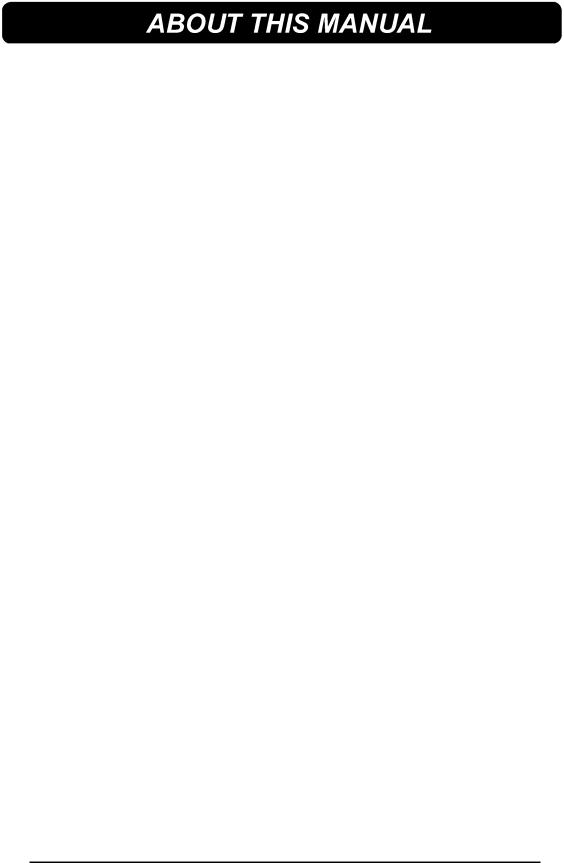
Although this machine is easy to use, we suggest that you read this manual carefully before starting. This manual consists of a reference guide and three main sections:
QUICK REFERENCE GUIDE |
This section provides a quick, simple guide to |
|
setting up and using the machine. |
BEFORE YOU START |
This section provides basic information con- |
|
cerning the machine itself, tape cassettes, and |
|
power supplies. |
LEARNING THE ROPES |
This tutorial section leads you through easy- |
|
to-follow practice sessions designed to help |
|
you become familiar with the machine’s |
|
operations. |
FOR YOUR INFORMATION |
This handy reference section contains detailed |
|
explanations of all the machine’s features. |
The Quick Reference Guide contains all the information you need to immediately begin using this machine to make simple labels. Please read the brief Before You Start section for more details on the setup and care of the machine.
If this is your first time using this machine, or if you would like to brush up on some techniques, we suggest you work through the exercises in Learning the Popes.
If you have detailed questions about specific features, the For Your Information section will provide you with the answers.
Good luck! We hope you enjoy using your P-Touch 580C.
1
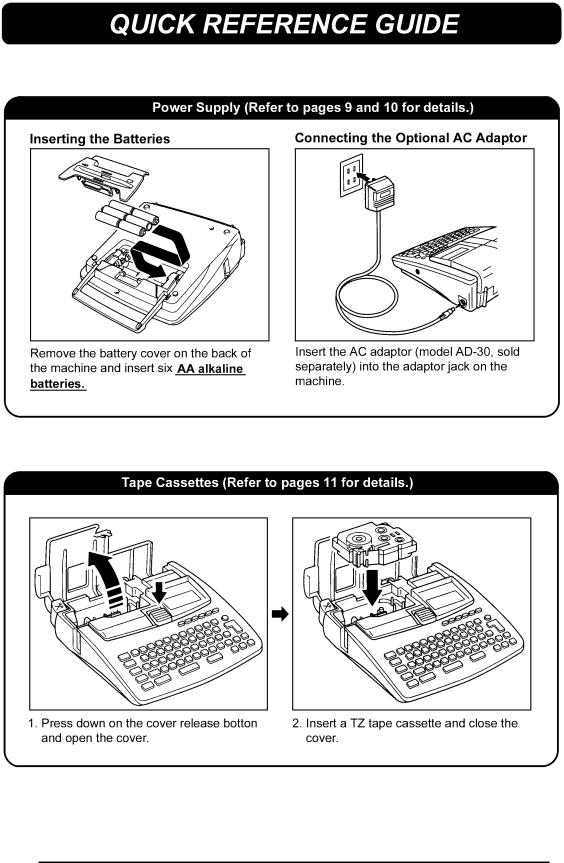
2

3
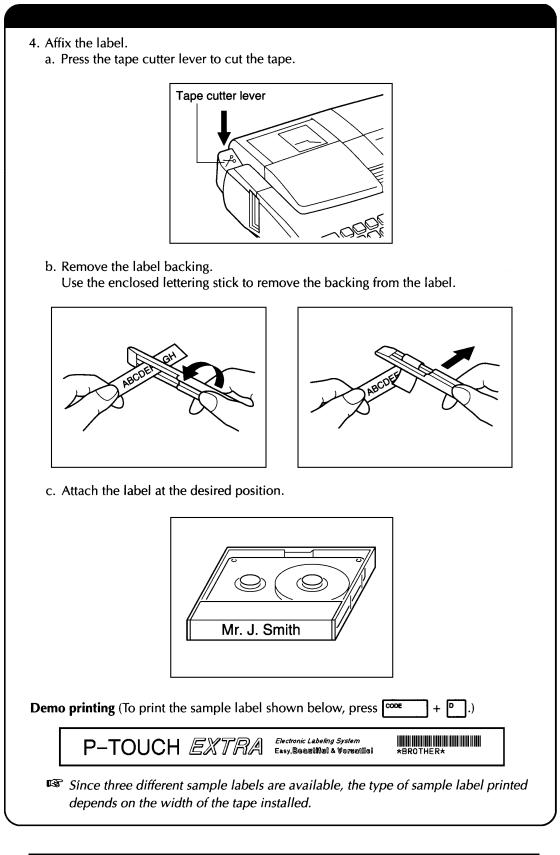
4
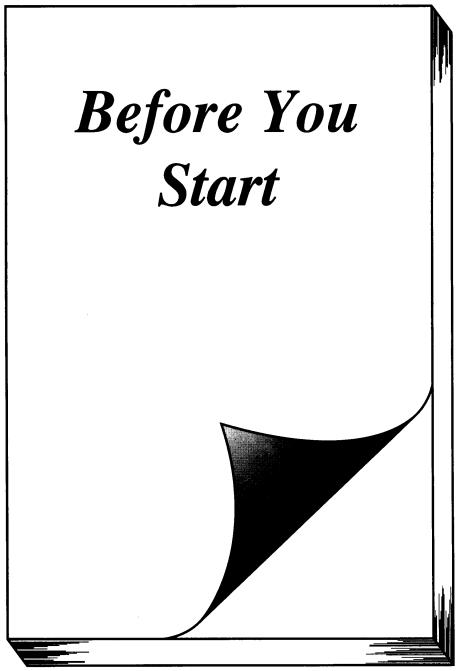
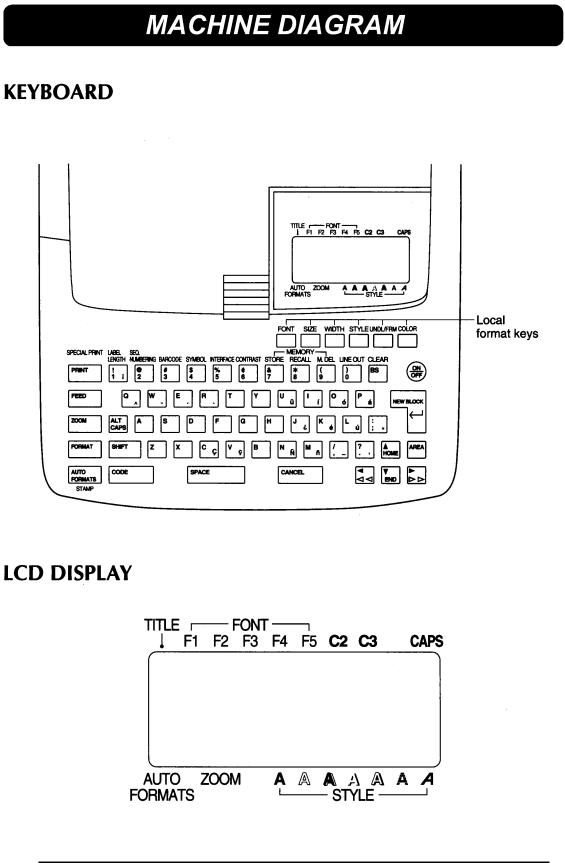
6
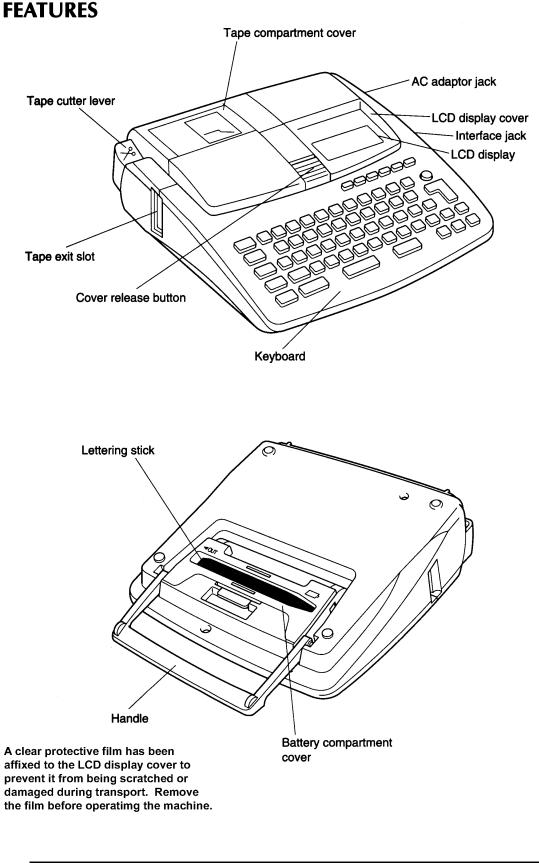
7
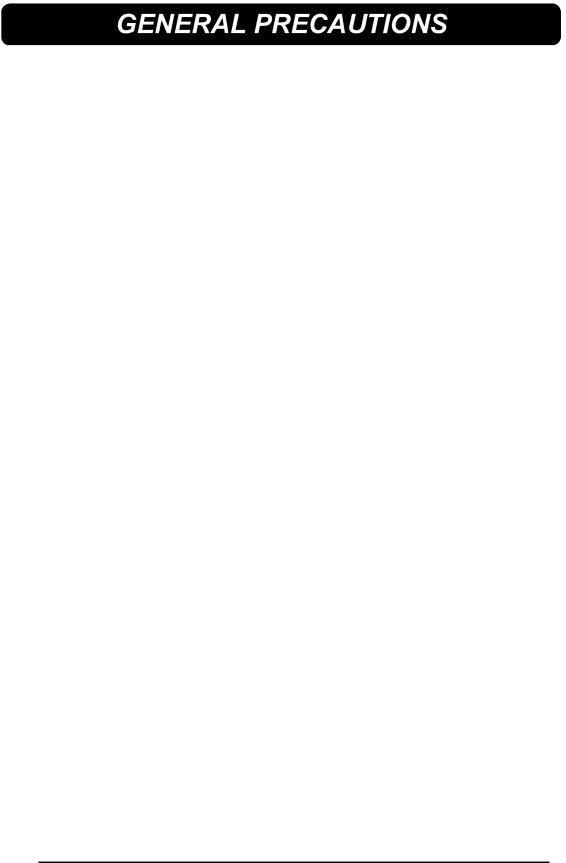
hUse only Brother TZ tapes with this machine. Do not use tapes that do not have the TZ mark.
hFive TZ tape widths are available: 1/4” (6 mm), 3/8” (9 mm), 1/2” (12 mm), 3/4” (18 mm), and 1” (24 mm).
hDo not pull on the tape. This may damage the tape cassette.
hAvoid using the machine in extremely dusty places. Keep it out of both direct sunlight and rain.
hDo not expose the machine to high temperatures or high humidity. Never leave it on the dashboard or in the back of your car.
hDo not leave any rubber or vinyl on the machine for an extended period of time. Doing so may cause staining.
hDo not clean the machine with alcohol or other organic solvents. Use a soft, dry cloth only.
hDo not put any foreign objects onto or into the machine.
hTo avoid injuries, do not touch the cutter’s edge.
hWhen inserting new batteries, be sure to do so within five minutes of removing the old ones, otherwise all messages will be lost (unless the machine is plugged into an AC outlet with the AC adaptor).
hUse only the AC adaptor (model AD-30) designed exclusively for this machine. Use of any other adaptor will void the warranty.
hWhen the machine is not being used for a long period of time and it is not necessary to keep the messages stored in the memory, remove the batteries to prevent them from leaking and damaging the machine and disconnect the AC adaptor.
hWhen the AC adaptor is plugged into the machine, unplugging the adaptor from the AC outlet can delete all messages in the memory, even though batteries are installed.
hUse AA alkaline batteries in the machine.
8
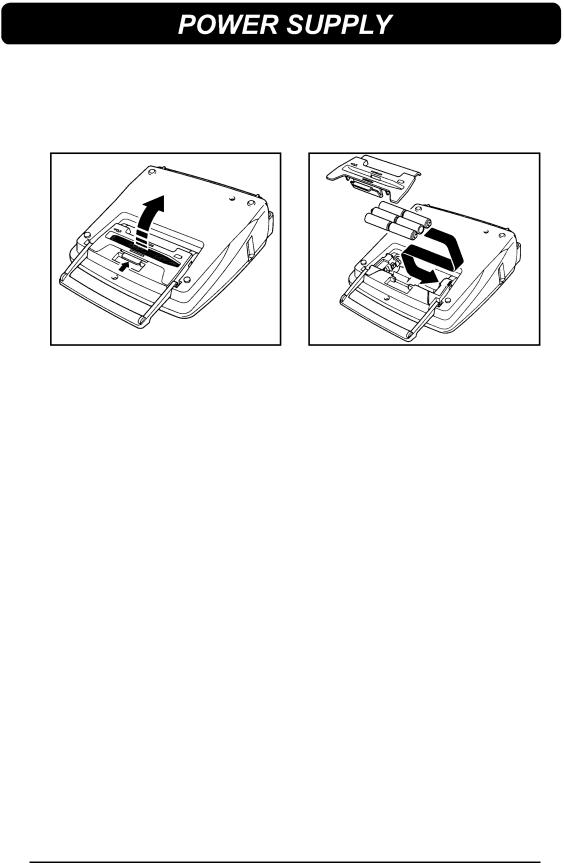
This is a lightweight and portable machine. It can be used anywhere by installing six (6) AA alkaline batteries. When you change the batteries, always replace all six at the same time.
+Be sure to insert the new batteries within five minutes of removing the old ones, otherwise the message in the working area and any messages stored in the memory will be lost (unless the machine is plugged into an AC outlet with the AC adaptor).
If alkaline batteries are not used, large fonts and bar codes cannot be printed.
9
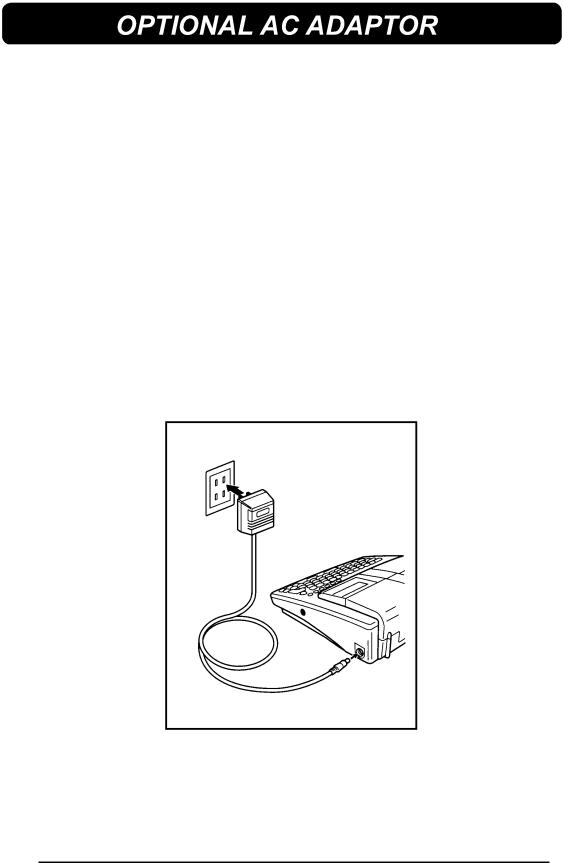
The AC adaptor (model AD-30) allows you to use this machine anywhere a standard electrical outlet is available.
TO ATTACH THE AC ADAPTOR:
(1)Insert the small plug on the adaptor into the jack marked DC IN 7V on the right side of the machine.
(2)Insert the large plug into the nearest standard electrical outlet.
+Only use the AC adaptor designed exclusively for this machine.
Remove the batteries and disconnect the AC adaptor if you do not intend to use your machine for an extended period of time. When the power is disconnected, all messages in the working area and the memory will be lost.
It is recommended that you use the AC adaptor when printing large fonts and bar codes on 3/4” (18-mm)- or 1” (24-mm)-wide tape since there operations can quickly run down the batteries.
10

This machine is equipped with a jack which allows you to print stamp and labels that you create with the P-touch EDITOR software installed on your IBM or compatible PC.
TO CONNECT THE COMPUTER:
(1) |
Be sure both the P-Touch 580C and the computer are turned off. |
(2) |
Insert the small plug on the connection cable into the jack marked |
|
INTERFACE on the right of the P-Touch 580C. |
(3) |
Insert the large plug into the COM port of your IBM computer. |
+ |
Use the plug that is compatible with the COM port on your computer |
|
and leave the other plug unconnected. |
(4) |
Turn on the P-Touch 580C, then start up the computer. |
+Hold down the CODE key and press the INTERFACE key on the P-Touch 580C to enter Interface mode.
Only use the connection cable designed exclusively for this machine.
11
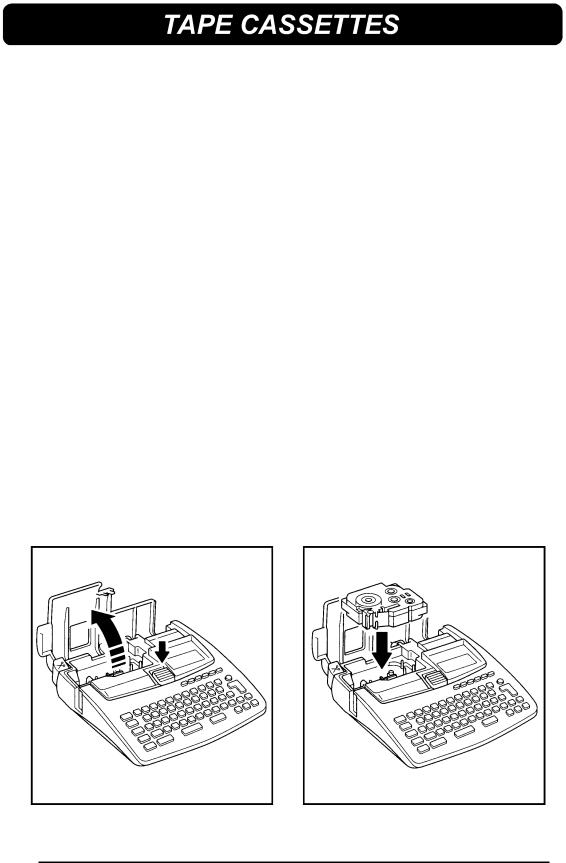
A single TZ tape cassette is supplied with this unit. However, since TZ tape cassettes and multi-color ink and tape cassettes are available for this machine in a wide variety of colors and sizes, it is possible to make distinctive color-coded and stylized labels.
In addition, this machine has been designed to allow you to change the tape cassettes quickly and easily.
TO INSERT A TZ TAPE CASSETTE
(1)Press down on the cover release button and lift open the compartment cover.
(2)If there is a cassette already in the compartment, remove it by pulling it straight up.
(3)Remove the stopper from a new tape cassette and if the ink ribbon in the cassette is loose, use your finger to wind the toothed wheel in the direction of the arrow on the tape cassette until the ribbon is taut. If you are using an old tape cassette, be sure the ribbon is taut before inserting it into the unit.
(4)Insert the tape cassette firmly into the compartment, making sure that the entire back of the cassette contacts the bottom of the compartment.
+When inserting the tape cassette, make sure that the inner ribbon does not catch on the corner of the metal guide.
(5)Close the compartment cover, then turn on the machine if necessary.
(6)Press the FEED key once to advance the tape and remove any slack.
(7)Push down on the tape cutter lever to cut off the excess tape.
12
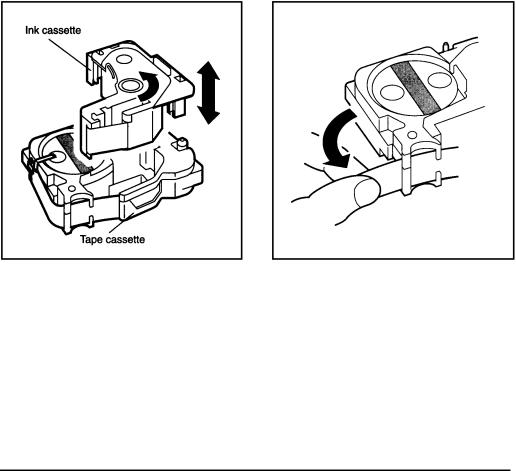
TO INSERT MULTI-COLOR INK AND TAPE CASSETTES:
(1)Press down on the cover release button and lift open the compartment cover.
(2)If there is a cassette already in the compartment, remove it by pulling it straight up.
(3)If the ribbon in the ink cassette is loose, use your finger to wind the toothed wheel in the direction of the arrow on the ink cassette until the ribbon is taut. Then, insert the ink cassette straight down into the tape cassette.
(4)Take the adhesive tape off the end of the label tape and pull out about 1/2” (12 mm) of label tape. If you are using an old tape cassette, be sure that the tape is sent through the cassette and the end of the tape goes under the tape guides.
(5)Insert both the ink and tape cassettes firmly into the compartment.
+When inserting the cassettes, make sure that the ribbon does not catch on the corner of the metal guide that the tape does not catch on the cutter.
(6)Close the compartment cover, then turn on the machine if necessary.
(7)Press the FEED key once to advance the tape and remove any slack.
(8)Push down on the tape cutter lever.
13
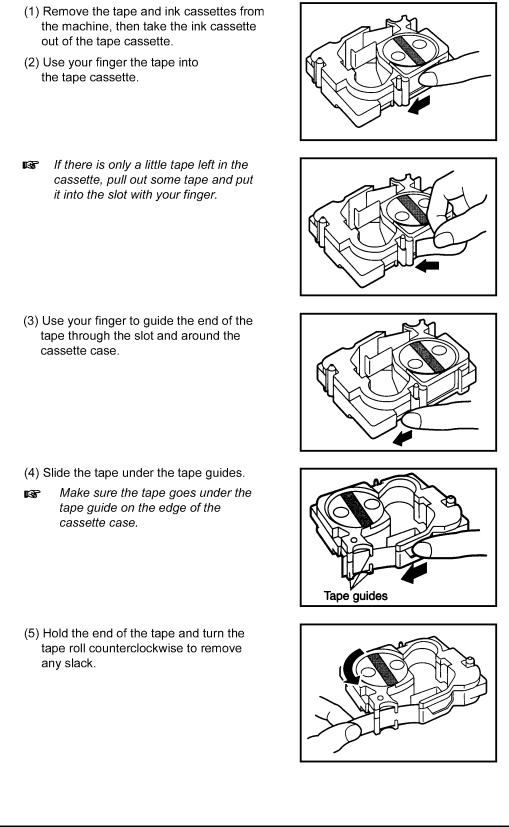
If too much of the tape is rewound back into the cassette:
14
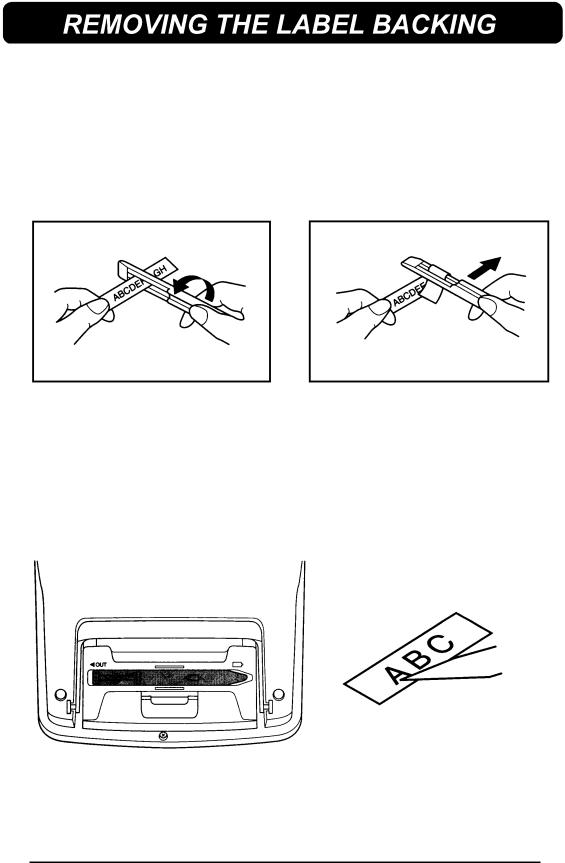
The enclosed stick enables you to remove the label backing from the tape easily.
(1)Hold the tape in your left hand, with the printed surface facing up, and hold the stick in your right hand.
(2)Pass the tape halfway through the long narrow hole in the stick.
(3)After turning the stick three quarters of a turn towards you, pull the stick away from you as shown below.
INSERT LETTERING TAPE (RUB-ON TRANSFERS)
Insert lettering tapes act as rub-on character transfers. After creating a message, position the label on a sheet of paper. Then, by simply rubbing the instant lettering tape’s non-printed side with the enclosed stick or one available on the market, you can transfer the tape’s contents directly onto the paper.
Caution: Hold the tape very firmly and do not move it while rubbing the tape.
15
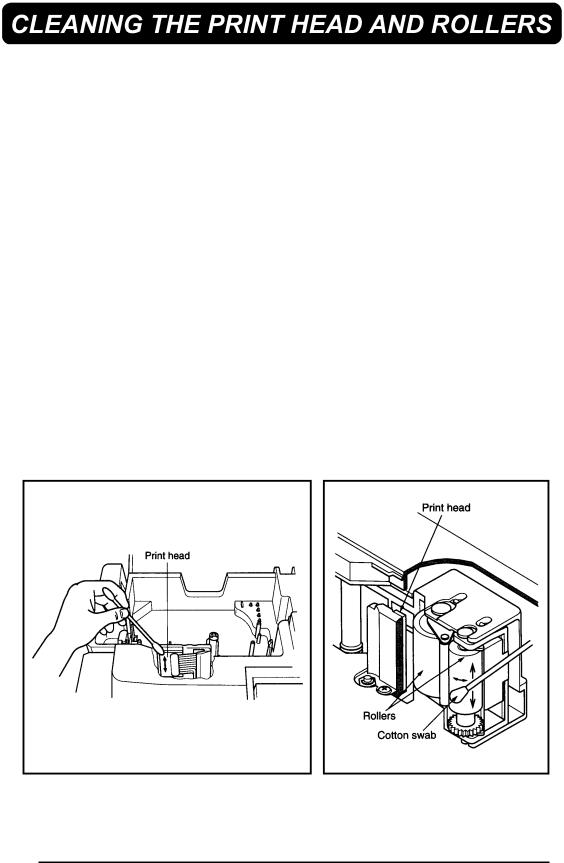
Occasionally, specks of dust or dirt become attached to the machine’s print head and rollers. This is particularly likely when you are using the unit outdoors or in a very dusty environment. If a section of the print head is covered with dust, a blank horizontal streak may appear through the label message.
Therefore, as with a tape recorder, the machine’s head may need to be cleaned from time to time.
TO CLEAN THE PRINT HEAD:
(1)Turn off the machine.
(2)Open the tape compartment cover and remove the tape cassette. The print head and rollers are located in the tape compartment.
(3)Print head: Use a dry cotton swab to gently wipe the print head with an up- and-down motion.
Rollers: Use a dry cotton swab to wipe each roller with an up-and-down motion while rotating them with your finger.
(4)Try printing again.
If dust still remains:
(5) Repeat step (3) using a cotton swab dipped in isopropyl (rubbing) alcohol. If none of the above works, contact you service representative.
16
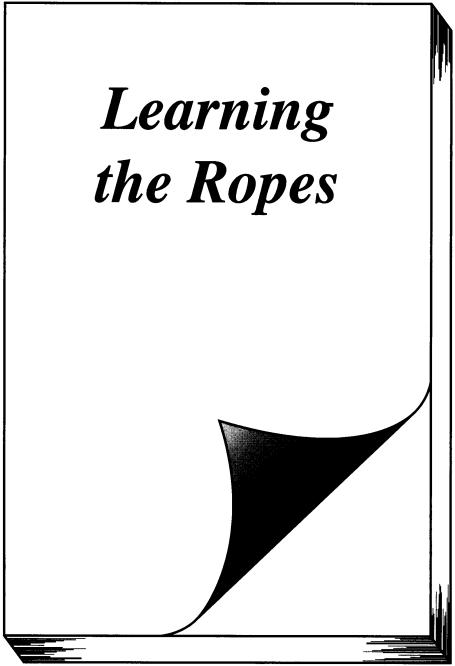
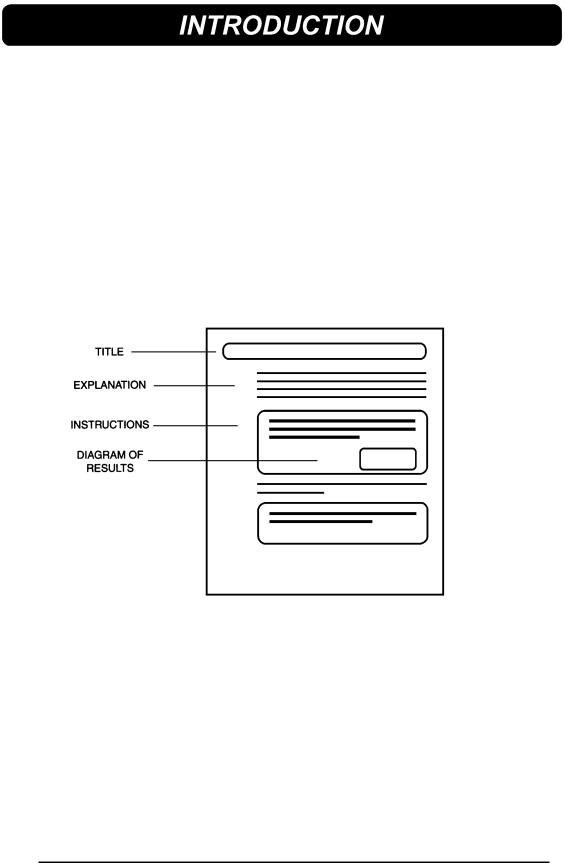
In Learning the Ropes, you will find a series of label-making examples. As the featured label designs become increasingly more complex, you will learn how
to use the more advanced features of the machine. The first exercise consists of creating a simple one-line door sign. The second, an equipment instruction label, takes advantage of several additional machine capabilities. The third is a fourline address label. Finally, the storage shelf label shows you how to use the unit’s more expert functions.
If you are a first time user, we suggest that you work through there exercises to become acquainted with the various features of this machine. Since they do not require much time, they can be done in four separate practice sessions or all at once.
The Learning the Ropes examples consist of the following parts:
To best use this training section, simply follow the flow of the practice sessions. Read the background explanations, then follow the instructions, checking that your results match the diagrams provided. If you would like more detailed information about a particular point, simply check in the For Your Information section.
And now, let’s see how easy it is to make beautiful labels with the P-Touch 580C!
18

Let’s begin by turning on the power to the machine. The power button is located in the top right-hand corner of the keyboard.
The text entry mode on this machine is WYSIWYG (What You See Is What You Get) mode, which allows you to see the label as it will appear after it is printed. The flashing mark resembling bracket is called a “cursor”. The mark is like a pointer which shows your current position and lets you select certain characters in your text.
The message you create may sometimes be longer then this machine’s LCD can display ant one time. In this case, the cursor can be moved to view hidden parts of the text. If a character key or the cursor key is pressed when the cursor is one the right end of the display, the text scrolls to the left one character at a time and the cursor stays at the right side of the display. If the left cursor key is pressed when the cursor is on the left side of the display, the whole text scrolls to the right, leaving the cursor at its position in the text unless this would cause it to move beyond the display, in which case the cursor is positioned to the left of the last character on the right side of the display.
The format settings are shown by the triangles and circles which appear at the top and bottom of the display. The default settings shown when the power is
19
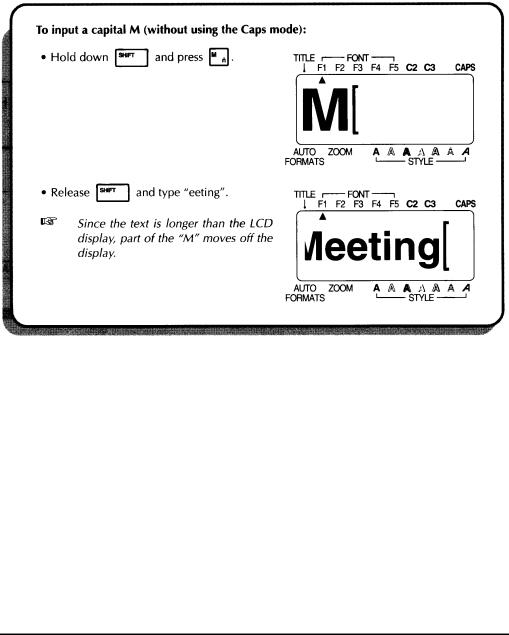
turned on for the first time have been preprogrammed into the machine and represent the most common style settings for labels. However, you can create your own formats and can even define local formats, which are special style settings for portions of text within the label. Detailed explanations for creating and editing global and local formats can be found in the Global Formatting and Local Formatting sections of For Your Information.
This machine is also equipped with an Auto format function which allows you to enter text and symbols into preset label templates. With the Auto format mode, you can enter text into common formats so labels can be create easily and printed quickly.
Now, let’s begin entering the text for our first label. To do so, we must first input a capital “M”.
As on a typewriter, the SPACE key allows you to add a blank space in the message.
+The SPACE and 4 keys different functions. The 4 key moves the cursor forward through inputted text without adding blank spaces.
20
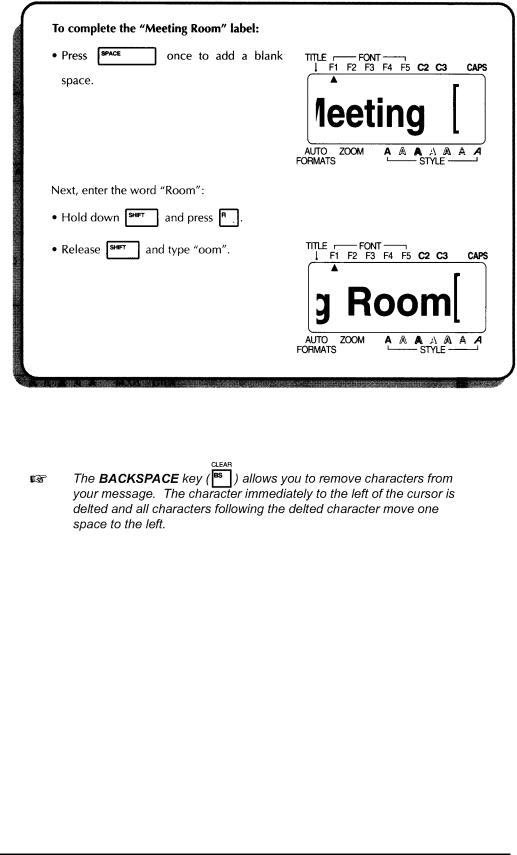
Once you have created a message, you can easily edit it by correcting mistakes or simply adjusting the text or style. For detailed explanations of text editing methods, see pages 63 to 65.
Now, let’s revise this label using the BACKSPACE key to delete the lowercase letters in our message and use the Caps mode, which allows us to enter a string of capital letters without holding down the SHIFT key, to enter uppercase characters which are mode appropriate for a door sign.
21
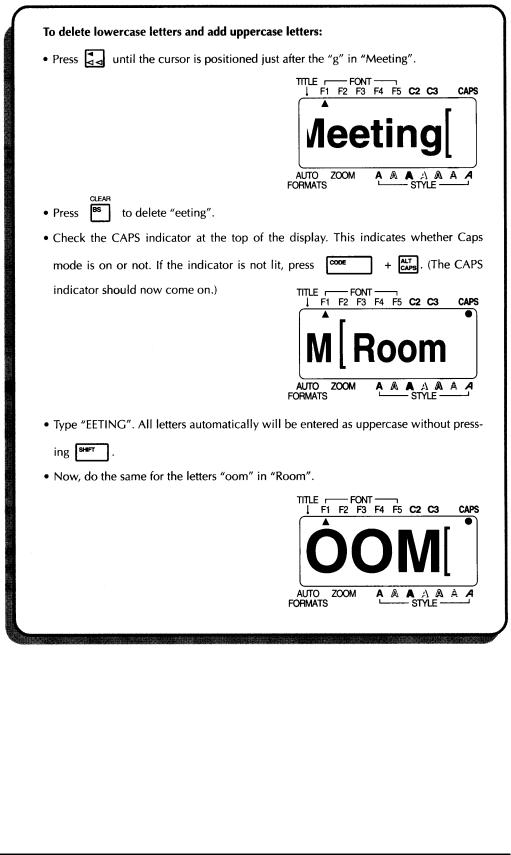
Finally, suppose we would like to add a no smoking symbol, just one of many available on this machine, to our door sign. A detailed explanations of symbol entry can be found in the Symbols section on page 52.
22
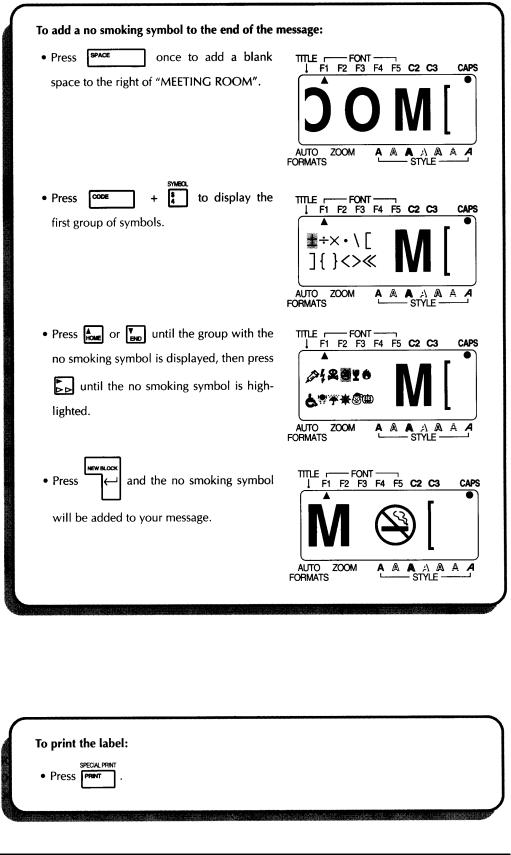
+You can press the CANCEL key at any time to return to text entry mode
from Symbol mode.
Since our message is finished, we can now print it. Though several print settings are available, we will use the default settings preprogrammed into the machine.
23

+The label this example can be printed on 3/4” (18-mm)- or 1” (24-mm)-wide tape.
Although the entered characters may not seen to align properly in the LCD display, they will line up correctly on the printed label.
In this practice session, we will make a multi-line equipment instruction label.
Let’s assume we want to make an instruction label for an office photocopier. First, we will enter four lines of text containing both uppercase and lowercase letters, then edit it into a three-line label. If you have any questions about basic inputting, please review the previous example (Door Sign) or see pages 50
to 55 of For Your Information.
24
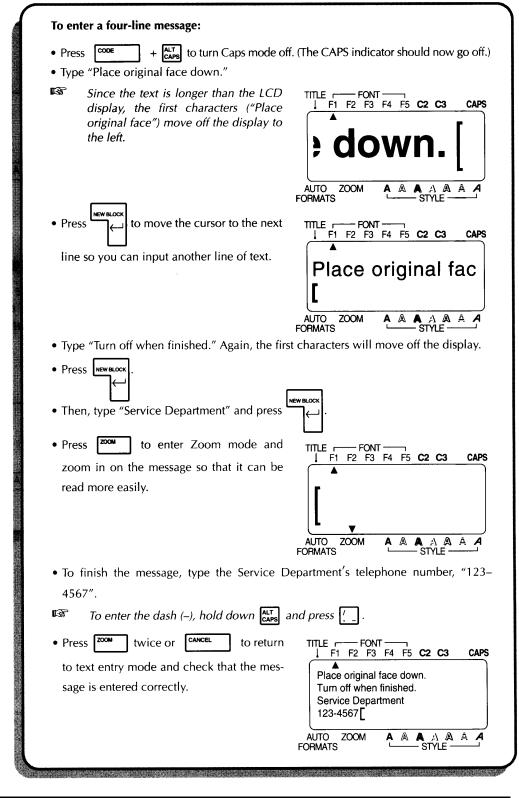
In our multi-line message, we will be using the RETURN key to end one line and start the next. This key operates like the Return on a typewriter by ending
the current line and moving the cursor to the next line.
25
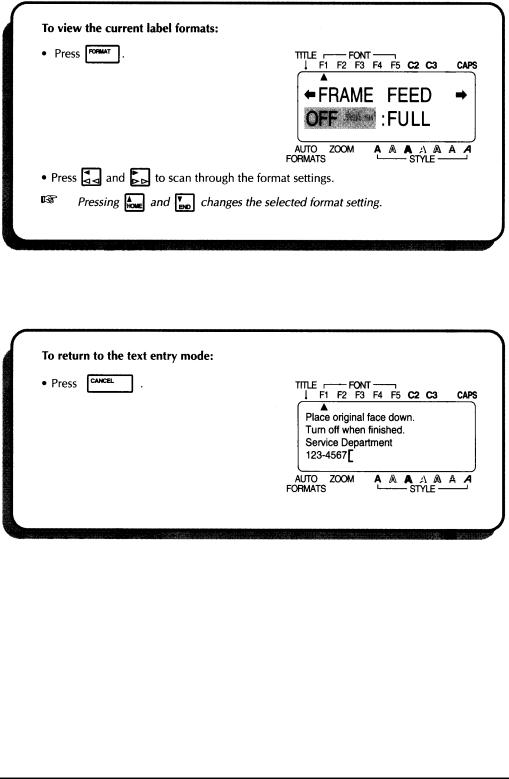
Press the FORMAT key at any time to view the current label formats. These settings can only be applied globally, i.e. to the entire message. For detailed explanations of the global format settings, see pages 93 to 103 of For Your Information.
Any time you wish to return to text entry mode from Format mode without changing any of the settings, simply press the CANCEL key. A detailed explanation of the CANCEL key can be found on page 60 of For Your Information.
26
